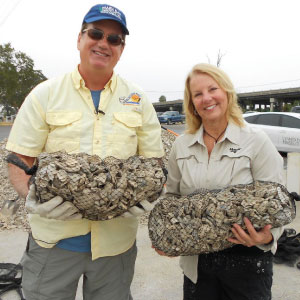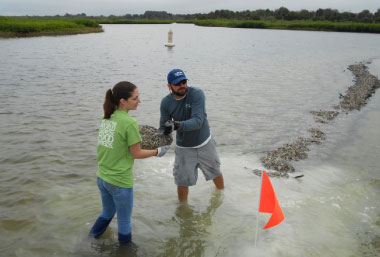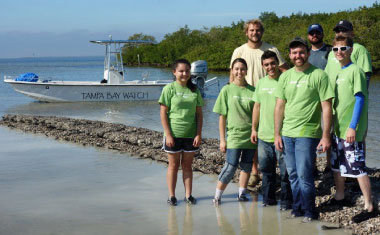By Sonia C. Lavina

I wasn’t sure what I was getting into when I signed up to help Tampa Bay Watch and a team of about 40 employees from the Mosaic Company install an oyster shell bar along the shoreline of the Schultz Nature Preserve on Hillsborough Bay near Gibsonton.
I had heard about the importance of oysters for maintaining water quality — just one oyster can filter 50 gallons of water a day, or 1,500 times its body volume. As filter feeders, oysters remove excess nutrients, bacteria and organic matter, improving overall water quality. Oyster reefs also serve as feeding grounds for wading birds and game fish such as snapper, grouper and snook. (Although Tampa Bay oysters have been off-limits for decades because of high bacteria levels, they’re economically important as a commercial food source in other locations.)
The day I participated was Day Two of a three-day project. On December 6, TBW had 35 volunteers including students from King High School at the same location. Then on Saturday, Eagle Scout Cody Czhran had recruited 60 volunteers for the project.
Schultz Nature Preserve is located in what old-timers called “The Kitchen” because they knew they could count on catching dinner there. Then, in the mid-1960s, it became part of a large dredge-and-fill project that created uplands for port development. About half of the man-made peninsula jutting into the bay was purchased by Hillsborough County’s Environmental Land Acquisition and Protection Program and the Southwest Florida Water Management District to restore fish and wildlife habitat (See Bay Soundings, Winter 2005).
While the Schultz Preserve is one of the region’s most successful restorations, erosion is still a concern. Along with filtering water and providing habitat, oyster reefs help to reduce erosion by minimizing wave action. Once this project is complete, eight new oyster shell bars spanning 1850 linear feet will help protect the shoreline.
It’s an immense undertaking. Our three-day project required 30 tons of oyster shell to create about 300 linear feet of new oyster reef. Volunteers moved the shell in about 2,000 plastic mesh bags that each weighed about 30 pounds each.
Once the shell is in place, it will attract juvenile oysters almost immediately. “You can start to see small oysters after about three months under ideal conditions,” said Peter Clark, TBW president. “After about two years, the oyster shell reef will have a mature growth of oysters covering the shell bar.”
Since the 1950s, at least half of the oyster communities in Tampa Bay have been lost due to dredge-and-fill activities and other developmental impacts, Clark said, but populations appear to be stabilizing. What’s needed most is habitat — areas with hard rough surfaces where juvenile oysters can attach, like the oyster bars we’re building today.
The Schultz project is part of TBW’s Community Oyster Reef Enhancement (CORE) program. It’s funded partially through the largest gift TBW has received in its 20-year history — a $225,000 grant from the Mosaic Foundation to build oyster bars at Schultz and complete other water quality initiatives over the next three years.
Mosaic also will be actively involved in oyster habitat restoration through employee volunteer days. “It’s a great team building activity. It’s hard work, it’s dirty but to go out to the bay and see the positive impact it has on the environment makes it all worthwhile,” said Christine Smith, community relations manager for Mosaic. “It’s great what Tampa Bay Watch is doing and we are glad to be a part of it.”

When I arrived at Williams Park boat ramp near the mouth of the Alafia River, a group of Mosaic volunteers and the TBW team were ready to get to work. The Environmental Protection Commission of Hillsborough County and the Florida Wildlife Research Institute provided their boats to transport the oyster shells. Additionally, TBW had two boats and one of their long-time volunteers had another.
Clark and Kevin Misiewicz, TBW’s environmental scientist and project manager for the Schultz Preserve, kicked off the morning with a short demonstration on how to fill mesh bags with the fossilized shells. Volunteers would shovel the shell into a PVC pipe “sleeved” with a mesh bag. Once the PVC form was removed, we’d end up with an oyster shell bag tied at both ends.
We loaded the bags into waiting boats, where they would be unloaded and deployed by hand in an intricate pattern that mimics natural oyster bars. Staff from TBW was on-site to ensure accurate placement and to minimize human impact on seagrass beds and other sensitive habitat.
Misiewicz explained that although the mesh is made from plastic, it has not been shown to have adverse effects on wildlife. “It keeps the oyster shell contained and is eventually completely encrusted with live oyster and is no longer visible or exposed,” he added.
According to Clark, oysters prefer to settle and attach to other oyster shells first, but they will settle on any available hard surface. Fossilized shells from local shell mines used in this project provided a hard surface for oyster larvae to settle upon and grow. “There is no difference in using fossilized shells or recycled shells in the environment – they both provide hard-bottom habitat that oysters love,” said Misiewicz.
After the demonstration, half of the Mosaic volunteers began shoveling fossilized shells into the mesh bags while a second group of volunteers assisted in the laying of the shell bags. It was clear that Melinda Spall, TBW environmental specialist, and Serra Herndon, habitat restoration director, had done this job before as they easily hefted the filled bags onto waiting boats.
“These types of oyster restoration projects are a lot of fun,” said Herndon. “It never ceases to amaze me how dedicated our volunteers are and how hard they work – and getting a good group of volunteers to participate always makes our job a lot easier.”
I rode out to the reef-in-progress on a TBW boat with about 70 bags of shell. Adam Hange, a committed TBW volunteer, was driving the boat and Misiewicz was also onboard. The bags were not only heavy, they were slippery and wet so I was glad to be wearing water shoes and heavy-duty gardening gloves.

Hange has been volunteering with TBW since 2005, often taking vacation time to help out with these projects. “You plant the seed and watch it grow year after year and you do it with people who have the same kinds of interests that you do,” he said. “It’s a great feeling and a great way to give back to the community — and look, we are out on a boat!”
We arrived at the site after a 20-minute ride and watched as Misiewicz and the Mosaic volunteers strategically placed the oyster bags adjacent to the shoreline where they would be covered by water during high tides. I returned to the boat ramp with Hange to get another load of shells.
After the first couple of trips, I was a little sore but the aches were more than outweighed by the feelings of accomplishment. Hange said it best: “It’s a wonderful feeling at the end of the day; your muscles are a little sore. But to go out to the project a year later and see how it grows, it’s a warm feeling you have in your heart. I’ll be able to take my children and grandchildren to the same project and explain to them how they can make a difference during their lives and their generation as we did in ours.”
Personally, I was amazed to see what a positive impact a group of volunteers can have on the environment in just one morning.
And they couldn’t do it without us! “Community volunteers are critical in our efforts to improve water quality and rebuild fish and wildlife habitats in Tampa Bay,” says Clark. Adds Rachel Arndt, TBW volunteer coordinator, “Our volunteers range from children to retirees, and people of all abilities are needed to assist with our projects.”
To learn more about upcoming TBW volunteer opportunities, visit www.TampaBayWatch.Org or the calendar section of Bay Soundings at http://baysoundings.com/Quarterly-Calendar.asp.
[su_divider]Originally published Spring 2013